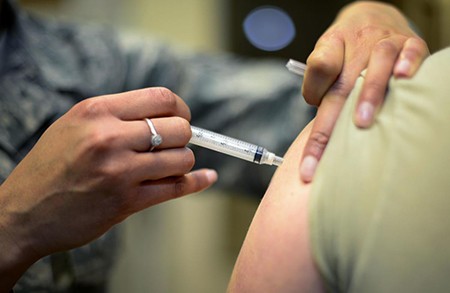It’s been a rough winter for respiratory viruses, and some hospitalized patients are testing positive for combinations of COVID-19, flu and RSV at the same time.
The symptoms of these dual infections are similar to those that people would have if they had one illness: a bad cough, a fever, aches, exhaustion and difficulty breathing for some.

It’s impossible to say whether people who have double infections of COVID-19 and flu or flu and RSV or RSV and COVID feel twice as lousy.
“They feel pretty terrible,” said Dr. Michelle Barron, senior medical director of infection prevention and control for UCHealth and a professor of medicine and infectious diseases at the University of Colorado School of Medicine on the Anschutz Medical Campus.
While some people are getting double whammy illnesses, others are getting COVID-19, then getting hit almost immediately with a case of influenza or RSV, or the other way around.
Getting two respiratory viruses at the same time is called a co-infection. Getting them one after another is known as a sequential infection.
A small percentage of patients who are so sick that they need to be hospitalized for flu, COVID-19 or RSV – less than 5% – are testing positive for two infections at the same time, Barron said.
If you, your friends or your family members are sick right now, you’re not alone. And if you feel really lousy, be sure to get help from your doctor. It’s possible that they’ll have some medications that can help you.
When should you seek help from a doctor?
“If you’re not able to eat or drink, if your fever persists, or it went away and it comes back, or if you have any kind of breathing issues or if you’re in a high-risk group – over 65 or you have an underlying medical condition – seek help because there may be treatments like Tamiflu or Paxlovid that your doctor can offer you,” Barron said.
Soon after the pandemic began in 2020, doctors were worried about multiple viruses circulating at the same time during the traditional fall and winter respiratory virus season.
At first, flu cases declined. So doctors were primarily addressing cases of COVID-19.
But since those early days, flu and RSV infections have come roaring back.

What’s happening with cases of COVID-19, flu and RSV now?
Cases of flu, COVID-19 and RSV are all on the rise, Barron said. At the same time, many people are suffering with a nasty stomach bug called norovirus.
People who are immunocompromised should take precautions to avoid getting sick. And everyone who is eligible should consider getting vaccinated to prevent annual respiratory illnesses.
“It’s not too late to get your vaccines,” Barron said.
The first wave of flu A cases may be peaking soon, which is typical for the winter respiratory season, Barron said. Flu A normally hits first. Then, we often get a second wave of flu B. People who get their flu shots now could still protect themselves from a flu B infection in the coming weeks.
“Flu cases seem to be plateauing at a high level now,” Barron said. “We’re probably heading toward the peak for flu, but then there’s typically a second upswing in cases of flu B in March and April,” Barron said. “That’s why is still worthwhile to get your shot. You can still protect yourself against circulating flu A and future flu B.”
Hospitalizations for COVID-19 have been rising since summer lows. And thankfully, the number of COVID-19 hospitalizations this winter are the lowest they have been compared to when the pandemic began.
These trends are signaling to Barron that we are now settling into a new normal pattern for the winter respiratory season.
“COVID-19 is behaving more like the flu,” Barron said.
Yes, people can get COVID-19 all year round, but just like the flu, COVID-19 infections appear to be climbing most during the fall and winter respiratory virus season.
Experts at the U.S. Centers for Disease Control and Prevention (CDC) confirmed recently that this pattern is taking hold across the country.
“Prior to the COVID-19 pandemic, many hospitalizations due to respiratory illness were caused by flu and RSV. But COVID-19 changed respiratory illness patterns. During the 2020-2021 and 2021-2022 seasons, flu and RSV activity were significantly lower than usual,” CDC experts said in a Jan. 12 update.
“The 2022-2023 season marked a departure from the previous two seasons, with flu and RSV circulating simultaneously with COVID-19 at high levels and peaking early,” they said.
This winter respiratory virus seasons marks the second year in a row when we’ve experienced a “tripledemic,” when COVID-19, flu and RSV all are circulating at the same time.
“COVID-19 continues to cause a larger number of hospitalizations and has been involved in many more deaths than flu and RSV combined,” CDC experts said.
But in a Jan. 22 CDC update, health experts noted that flu cases are causing many ER visits now.
It’s strange that people can get both COVID-19 and flu at the same time or both RSV and COVID-19. How do doctors detect these infections?
Since testing has declined dramatically since the worst days of the COVID-19 pandemic, very few people who are sick know exactly what they have.
Some people are getting so sick that they need to receive help in hospitals. That’s when doctors test patients for a variety of viruses. And with some patients, they detect co-infections.
“It’s not common, but we have some patients now who have both COVID-19 and RSV,” Barron said.
“We also see combinations of rhinovirus and flu too,” she said.
Rhinovirus, which causes the common cold, is the most common respiratory virus that humans get. So it’s not surprising that patients can get dual infections that include rhinovirus. Most of the time, however, people don’t know what illness they have. They just feel sick.

Who is getting most sick now from flu, COVID-19 and RSV?
The trends are similar to what they have been throughout the pandemic, Barron said.
Older people and those who are immunocompromised are most vulnerable if they get the flu or COVID-19.
“Being over the age of 60 or having underlying medical conditions, like lung disease and asthma, puts people at greater risk for hospitalization,” Barron said.
“There appears to be a silver lining for everyone else. In general, everyone else who is getting COVID-19 now tends to get a mild respiratory illness,” she said. “So you still may feel sick and feel bad, but you’re not ending up in the hospital.”
Earlier in the pandemic, Barron said, older people who became gravely ill with COVID-19 were more likely to die from their infections, but the illness also was making many younger people very sick too.
Thanks to widespread vaccinations and increased immunities to the virus that causes COVID-19, Barron and other infectious disease experts around the U.S. are seeing fewer critically ill people who need to be hospitalized for COVID-19.
“The severity seems to have really tamped down significantly for most people,” Barron said.
When it comes to RSV, infants and children can get very sick if they get it. Barron said adults ages 51 and older also sometimes need to be hospitalized with RSV.
What about the newest COVID-19 variant, JN.1?
JN.1 is a descendant of omicron and is related to BA.2.86. JN.1 is now the dominant variant in the U.S. and around the world.
There is no evidence that JN.1 causes more severe illnesses than previous coronavirus variants, and COVID-19 vaccines should help prevent severe illness for those who get sick.
Barron advises people to get the newest COVID-19 vaccine if they haven’t done so already.
“The vaccine should still have efficacy against JN.1,” Barron said.
According to CDC data, as of Jan. 22 of this year, JN.1 accounts for 83 to 88% of COVID-19 cases in the U.S. right now. CDC experts have also detected JN.1 among international travelers and through wastewater monitoring.
What if I’m sick? Should I stay home, eat chicken soup and try to get well? Or should I go see my doctor?
People who are sick and are in high-risk groups — like older people, transplant patients and others who are immunocompromised — should get in touch with their doctors if they are sick.
And anyone who is having trouble breathing should seek help immediately.
“If you find that you’re having breathing issues, don’t delay. Get in to see your doctor. Also if you can’t eat or drink anything and you’re becoming dehydrated, you need to get help,” Barron said.
Editor’s Note: The Colorado Times Recorder occasionally posts articles, like this one, about COVID-19 from UCHealth Today, which is published by UCHealth, the hospital associated with the University of Colorado School of Medicine. Our goal is to provide as many people as possible with accurate information about medical issues that are poisoned by misinformation, particularly as discussed on social media and talk radio.




